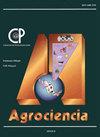基于可得产量和土壤有机质含量的玉米氮肥施用
IF 0.5
4区 农林科学
Q4 AGRICULTURE, MULTIDISCIPLINARY
引用次数: 0
摘要
农业土壤通常不能提供足够的氮来满足作物的需要,因此有必要将其作为肥料施用。这种供应可以通过对土壤的化学分析来估计,并在此基础上和植物的需求,为作物提出氮肥施肥建议。本研究旨在确定玉米(Zea mays L.)的经济最优施氮量,以可得产量和土壤有机质含量作为土壤氮供应的估算指标,在当前和增加的N/玉米价格比下,降低经济最优施氮量和施肥成本,以及N损失和环境污染。2011年、2012年和2013年,在墨西哥5个自然气候区进行了67项玉米对氮响应的试验,试验采用旱作和灌溉条件下的原生玉米和改良玉米。处理方式为:(1)氮、磷、钾施肥;(2)各营养素遗漏;(3)不施肥。实验设计为随机完全区组设计,无重复。对气候区旱作和灌溉条件下的生产函数进行了估算,并将产量作为可达产量等级、施氮量和土壤有机质含量的函数。利用生产函数估算经济最优施氮量,其中:(1)可达产量等级、土壤有机质含量的当前N/玉米价格比,以及最优经济产量和净收入;(2)氮素/玉米价格比的提高降低了经济最优施氮量和施肥成本,但经济最优产量和净收入未显著降低;这也减少了氮的损失和环境污染。本文章由计算机程序翻译,如有差异,请以英文原文为准。
NITROGEN FERTILIZATION FOR MAIZE BASED ON ATTAINABLE YIELD AND SOIL ORGANIC MATTER CONTENT
Agricultural soils generally do not provide enough N to satisfy crop needs, so it is necessary to apply it as fertilizer. This supply can be estimated by chemical analysis of the soil and, based on this and the needs of the plant, nitrogen fertilization recommendations are made for the crops. The objective of this study was to determine economic optimum N rates for maize (Zea mays L.), based on attainable yield and soil organic matter content as an estimator of soil N supply, with the current and increased N/maize price ratio, to reduce economic optimum N rates and fertilization costs, as well as N losses and environmental pollution. In 2011, 2012, and 2013, 67 experiments on maize response to N were distributed and conducted in five edaphoclimatic regions of Mexico, with native and improved maize in rainfed and irrigation conditions. The treatments were: (1) fertilization with N, P, and K; (2) omission of each nutrient; and (3) no fertilization. The experimental design was a randomized complete block design, without replications. Production functions were estimated for rainfed and irrigation conditions in edaphoclimatic regions, for yield as a function of attainable yield classes, amount of N applied, and soil organic matter content. The production functions were used to estimate economic optimum N rates, with: (1) the current N/maize price ratio for the attainable yield classes and soil organic matter contents, as well as optimum economic yields and net income; and (2) the increased N/maize price ratio, that reduced the economic optimum N rates and fertilization costs, without significantly decrease of the economic optimum yields and the net income; this also reduces N losses and environmental pollution.
求助全文
通过发布文献求助,成功后即可免费获取论文全文。
去求助
来源期刊

Agrociencia
农林科学-农业综合
CiteScore
0.50
自引率
33.30%
发文量
51
审稿时长
18-36 weeks
期刊介绍:
AGROCIENCIA is a scientific journal created and sponsored by the Colegio de Postgraduados. Its main objective is the publication and diffusion of agricultural, animal and forestry sciences research results from mexican and foreign scientists. All contributions are peer reviewed. Starting in the year 2000, AGROCIENCIA became a bimonthly and fully bilingual journal (Spanish and English versions in the same issue). Since 2007 appears every month and a half (eight issues per year). In addition to the printed issues, the full content is available in electronic format.
 求助内容:
求助内容: 应助结果提醒方式:
应助结果提醒方式:


